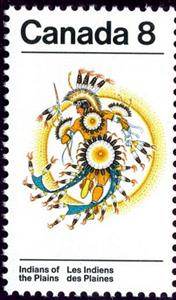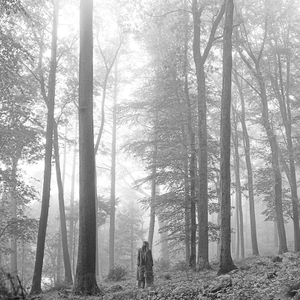Stamp: Assiniboine Dancer in Ceremonial Costume (Canada 1972)
Assiniboine Dancer in Ceremonial Costume (Canada 1972)
04 October (Canada ) within release Native Amerindians of Canada: Plains Indians goes into circulation Stamp Assiniboine Dancer in Ceremonial Costume face value 8 Canadian cent
| Stamp Assiniboine Dancer in Ceremonial Costume in catalogues | |
|---|---|
| Stamp Number: | Sn: CA 565pi |
Stamp is vertical format.
Tagged (GT2) on ribbed paper with low fluorescence (LF)Also in the issue Native Amerindians of Canada: Plains Indians:
- Stamp - Assiniboine Dancer in Ceremonial Costume face value 8;
- Se-tenant - Assiniboine Thunderbird and Tribal Dancer face value 2*8;
Stamp Assiniboine Dancer in Ceremonial Costume it reflects the thematic directions:
Dance is an art form, often classified as a sport, consisting of sequences of body movements with aesthetic and often symbolic value, either improvised or purposefully selected. Dance can be categorized and described by its choreography, by its repertoire of movements or by its historical period or place of origin. Dance is typically performed with musical accompaniment, and sometimes with the dancer simultaneously using a musical instrument themselves.
Folklore is the body of expressive culture shared by a particular group of people; it encompasses the traditions common to that culture, subculture or group. These include oral traditions such as tales, proverbs and jokes. They include material culture, ranging from traditional building styles to handmade toys common to the group. Folklore also includes customary lore, the forms and rituals of celebrations such as Christmas and weddings, folk dances and initiation rites. Each one of these, either singly or in combination, is considered a folklore artifact. Just as essential as the form, folklore also encompasses the transmission of these artifacts from one region to another or from one generation to the next. For folklore is not taught in a formal school curriculum or studied in the fine arts. Instead these traditions are passed along informally from one individual to another either through verbal instruction or demonstration. The academic study of folklore is called folkloristics.
In clothing, a suit is a set of garments made from the same cloth, usually consisting of at least a jacket and trousers. Lounge suits (also known as business suits when sober in colour and style), which originated in Britain as country wear, are the most common style of Western suit. Other types of suit still worn today are the dinner suit, part of black tie, which arose as a lounging alternative to dress coats in much the same way as the day lounge suit came to replace frock coats and morning coats; and, rarely worn today, the morning suit. This article discusses the lounge suit (including business suits), elements of informal dress code.



